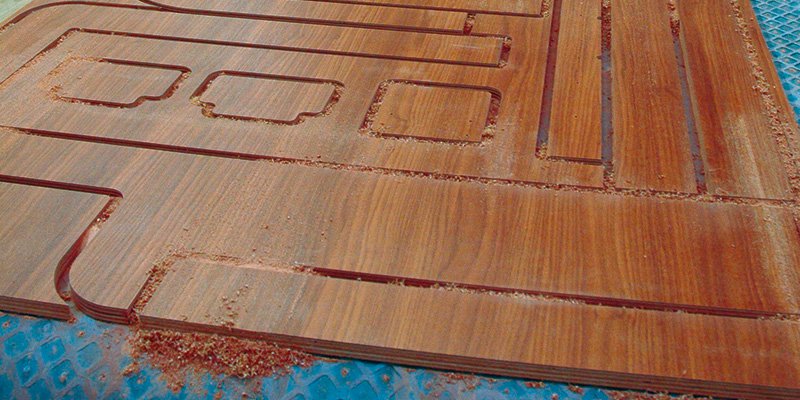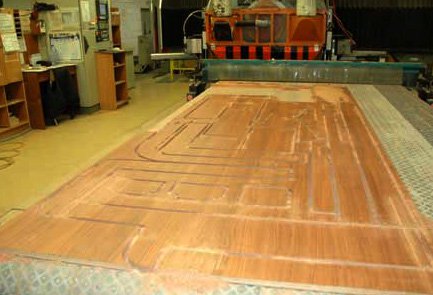Wood routing
Programming of machines that route nested wood panels using Almacam Routing
Thanks to the enhancement of CNC milling machines, automation of panel routing operations has made it possible to improve the processes for machining wood and wood-based materials. These machines are capable of performing a wide variety of machining operations, producing finished parts in increasingly complex shapes. This means a nesting software designed to route nested parts like Almacam Routing is vital in order to minimize material losses and provide highly automated programming of all the machining operations, regardless of the machine used.
Increasingly sophisticated machines
In the wood industry there are many different materials that can only be cut by sawing or milling (solid wood, chipboard, pressed wood, wood laminate, etc.). In the furniture-making industry, panels are usually cut or sawed into rectangular pieces. These pieces are then machined (drilled, routed, beveled, etc.) individually to produce the component parts of the furniture which will be assembled.
However, the shapes of these pieces are becoming increasingly complex, and less and less rectangular, especially for applications such as layout and interior fittings for yachts and recreational vehicles. So, the advantages of routing of nested parts are becoming increasingly valuable, to minimize material losses.
In addition, machines that route nested wood panels include numerous return tools or systems making it possible to carry out a wide variety of machining operations (drilling, screwing, grooving, rabbet, bevel, pocketing, routing, etc.) and produce finished parts that do not need to be individually reworked. These machines also incorporate suction systems to ensure the parts are securely held at the end of routing, guaranteeing high quality cutting and operator safety.

Main advantages and benefits of Almacam Routing for routing of wood panels
Significant material savings
Significant reduction of loss rates thanks to automatic nesting performance, since there is a choice of several available strategies.
Minimized programming times and risks of error
- For any 3D part imported from any CAD software, automatic recognition of technological characteristics on both sides (pocketing, drilling, grooving, rabbet and bevel) requiring no data keyboarding and reducing the risk of errors.
- Automatic assignment of the technological process (pocketing, drilling, groove, rabbet and bevel) and allocation of the adequate tool.
- Easy configuration and customization capabilities to define automatic machining strategies.
- Automatic nesting functions with no or limited user intervention required.
- Possibility to operate in full automatic mode.
Optimized time cycles
- Optimized computation of the tool paths.
- Automated management of tool order (drilling, screwing, riveting and routing) with possible interactive modification.
Complete mastering of the technological process
- Automatic or interactive management of pocketing (with or without island) and finish cut.
- Automatic implementation of additional pocketing for the shape cutters path that will be taken into account by the nesting module.
- Choice of several pocketing sequences: “spiral” or “Z” cuts.
- Constant depth management (spot facing, etc.)
- Tool turret management according to the machine capabilities and to the parts combined in the nesting.
- Management of multi-pass routing when the machining depth is too large.
- Management of curves and bevels on edges.
- Management of progressive depth lead-ins.
- Management of “top side”, “down side” and edge machining (automatically recognized).
- Unitary part machining with various wedging systems (blocks, suction, etc.)
- Management of “onion skin” cutting avoiding suction losses and allowing more secure holding of parts on the machine.
- Part surfacing allowing nesting with parts with different thickness on a single panel.
An approach that contributes to improving the quality of manufactured parts
- Automatic drill re-machining to cut notches out.
- Automatic or interactive management of pocketing (with or without island) and finishing cuts.
- Parts positioned in the nesting according to material fiber direction.
- Tool life increased by taking into account drill wear through the use of the tool correction feature.
- Optimized management of milling speeds to avoid tearing or burning phenomena.
Programming that guarantees safety on the machine.
- Suction constraints are integrated into the automatic nesting algorithms to secure the parts in complete safety during machining.
- Suction constraints supported in the routing sequence.
Methods to facilitate handling on the shop floor
- Minimization or elimination of partial nesting generating off-cuts that can be re-used but are costly to manage.
- Capability for engraving to identify parts when they are unloaded.

